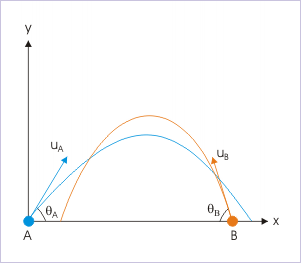| << Chapter < Page | Chapter >> Page > |
Collision between two projectiles is a rare eventuality. The precise requirement of collision is that the two projectiles are at the same position (having same x and y coordinates) at a given time instant. This is the condition for two point objects to collide or for a collision to occur. This is possible only rarely. Consider projections of two projectiles as shown in the figure.
Collision of projectiles

We see that paths of two projectiles cross twice. Thus, there are two positions (or corresponding time instants) when it is possible that projectiles occupy same position and thus may collide with each other. But, there are infinite possibilities that they would not. Projectile “A” may rise to the required height but “B” may be at lower or higher position. Similarly, even if two projectiles are at same height they may be horizontally separated. To top these, the projectiles may have time difference at the start of their motion. However, if two projectiles collide then we can make lot many simplifying assumptions resulting from the requirement of collision that two projectiles are at the same position at the same time. In this module, we shall examine these simplifying aspects of projectile motion under collision.
Two projectiles need to approach towards each other for collision to take place. If we look at this requirement in component form, then projectiles should approach towards each other both vertically and horizontally. It is possible that projectiles have different projection times. We can, however, extend the analysis even when projectiles are projected at different times by accounting motion for the additional time available to one of projectiles. For the sake of simplicity however, we consider that two projectiles are initiated at the same time instant.
The most important aspect of analysis of projectile motion involving collision is that we can interpret condition of collision in terms of relative velocity. We actually use the fact that components of relative velocity in either x or y direction is uniform motion - not accelerated one. This simplifies the analysis a great deal.
If “ ” is the initial separation between projectiles, then for collision they should cover this separation with x-component of relative velocity. Since two projectiles are initiated at the same time instant, the time when collision occurs is given by :
where is the relative speed of approach of A with respect B. Note that time expression evaluates to same value whether we compute it with or . On the other hand, if there is no initial separation in x – direction, the projectiles should cover same horizontal distance for all time intervals. It is so because projectiles have to reach same horizontal i..e x-position at the point of collision in two dimensional space. This means that relative velocity of projectiles in x-direction is zero for the condition of collision. Mathematically,

Notification Switch
Would you like to follow the 'Kinematics fundamentals' conversation and receive update notifications?